Heart disease in Canada: Highlights from the Canadian Chronic Disease Surveillance System
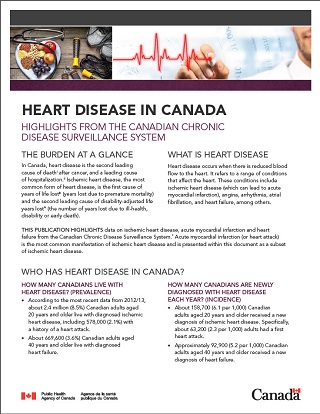
Download the entire report
(PDF format, 460KB, 6 pages)
The Burden at a Glance
In Canada, heart disease is the second leading cause of deathFootnote i
after cancer, and a leading cause
of hospitalization.Footnote ii
Ischemic heart disease, the most common form of heart disease, is the first cause of years of life lostFootnote iii
(years lost due to premature mortality) and the second leading cause of disability-adjusted life years lostFootnote iv
(the number of years lost due to ill-health, disability or early death).
What Is Heart Disease
Heart disease occurs when there is reduced blood flow to the heart. It refers to a range of conditions that affect the heart. These conditions include ischemic heart disease (which can lead to acute myocardial infarction), angina, arrhythmia, atrial fibrillation, and heart failure, among others.
This publication highlights data on ischemic heart disease, acute myocardial infarction and heart failure from the Canadian Chronic Disease Surveillance System.* Acute myocardial infarction (or heart attack) is the most common manifestation of ischemic heart disease and is presented within this document as a subset of ischemic heart disease.
Who Has Heart Disease in Canada?
How many Canadians live with heart disease? (prevalence)
- According to the most recent data from 2012/13, about 2.4 million (8.5%) Canadian adults aged 20 years and older live with diagnosed ischemic heart disease, including 578,000 (2.1%) with a history of a heart attack.
- About 669,600 (3.6%) Canadian adults aged 40 years and older live with diagnosed heart failure.
How many Canadians are newly diagnosed with heart disease each year? (incidence)
- About 158,700 (6.1 per 1,000) Canadian adults aged 20 years and older received a new diagnosis of ischemic heart disease. Specifically, about 63,200 (2.3 per 1,000) adults had a first heart attack.
- Approximately 92,900 (5.2 per 1,000) Canadian adults aged 40 years and older received a new diagnosis of heart failure.
Mortality Due to Any Cause
The likelihood of death increases as the disease progresses and symptoms become more severe. When compared to those without the condition, Canadian adults with diagnosed ischemic heart disease, who survived a heart attack and with diagnosed heart failure were three, four, and six times more likely to die prematurely respectively.
Heart Disease among Men and Women
The prevalence and incidence of diagnosed ischemic heart disease and heart failure are consistently higher among men than women (Figures 1 and 2). The difference by sex is more pronounced for the occurrence of acute myocardial infarction. On average, men are about 2 times more likely than women to have a first acute myocardial infarction. In addition, the gap between men and women in the overall number of acute myocardial infarction occurrences is steadily increasing over time. There were close to 80,000 more occurrences among men than women in 2000/01, compared to just over 200,000 occurrences in 2012/13.
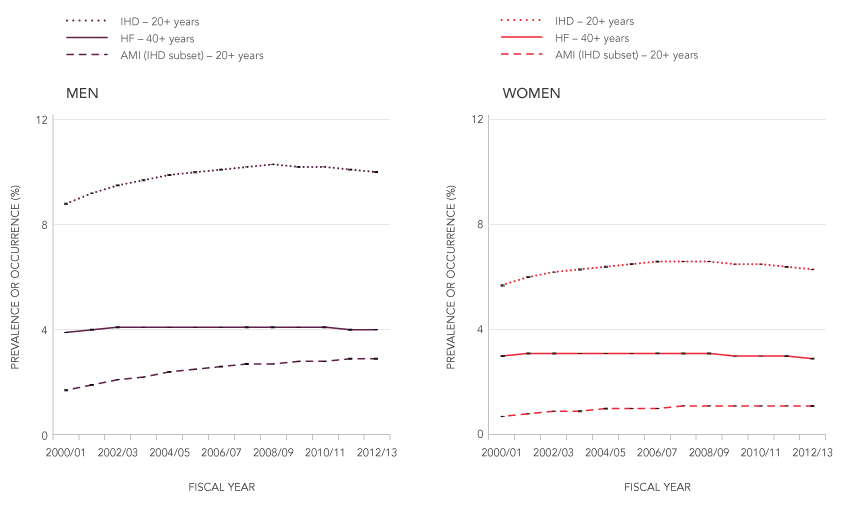
†Age-standardized to the 2011 Canadian population. *Data from Yukon were not available.
Notes: The 95% confidence interval shows an estimated range of values which is likely to include the true value 19 times out of 20.
Source: Public Health Agency of Canada, using Canadian Chronic Disease Surveillance System data files contributed by provinces and territories, May 2016.
Figure 1 - Text Description
| Ischemic heart disease | ||
| Fiscal Year | Prevalence among women aged 20 years and older | Prevalence among men aged 20 years and older |
| 2000/01 | 5.7 | 8.8 |
| 2001/02 | 6.0 | 9.2 |
| 2002/03 | 6.2 | 9.5 |
| 2003/04 | 6.3 | 9.7 |
| 2004/05 | 6.4 | 9.9 |
| 2005/06 | 6.5 | 10.0 |
| 2006/07 | 6.6 | 10.1 |
| 2007/08 | 6.6 | 10.2 |
| 2008/09 | 6.6 | 10.3 |
| 2009/10 | 6.5 | 10.2 |
| 2010/11 | 6.5 | 10.2 |
| 2011/12 | 6.4 | 10.1 |
| 2012/13 | 6.3 | 10.0 |
| Heart failure | ||
| Fiscal Year | Prevalence among women aged 40 years and older | Prevalence among men aged 40 years and older |
| 2000/01 | 3.0 | 3.9 |
| 2001/02 | 3.1 | 4.0 |
| 2002/03 | 3.1 | 4.1 |
| 2003/04 | 3.1 | 4.1 |
| 2004/05 | 3.1 | 4.1 |
| 2005/06 | 3.1 | 4.1 |
| 2006/07 | 3.1 | 4.1 |
| 2007/08 | 3.1 | 4.1 |
| 2008/09 | 3.1 | 4.1 |
| 2009/10 | 3.0 | 4.1 |
| 2010/11 | 3.0 | 4.1 |
| 2011/12 | 3.0 | 4.0 |
| 2012/13 | 2.9 | 4.0 |
| Acute myocardial infarction (ischemic heart disease subset) | ||
| Fiscal Year | Occurrence among women aged 20 years and older | Occurrence among men aged 20 years and older |
| 2000/01 | 0.7 | 1.7 |
| 2001/02 | 0.8 | 1.9 |
| 2002/03 | 0.9 | 2.1 |
| 2003/04 | 0.9 | 2.2 |
| 2004/05 | 1.0 | 2.4 |
| 2005/06 | 1.0 | 2.5 |
| 2006/07 | 1.0 | 2.6 |
| 2007/08 | 1.1 | 2.7 |
| 2008/09 | 1.1 | 2.7 |
| 2009/10 | 1.1 | 2.8 |
| 2010/11 | 1.1 | 2.8 |
| 2011/12 | 1.1 | 2.9 |
| 2012/13 | 1.1 | 2.9 |
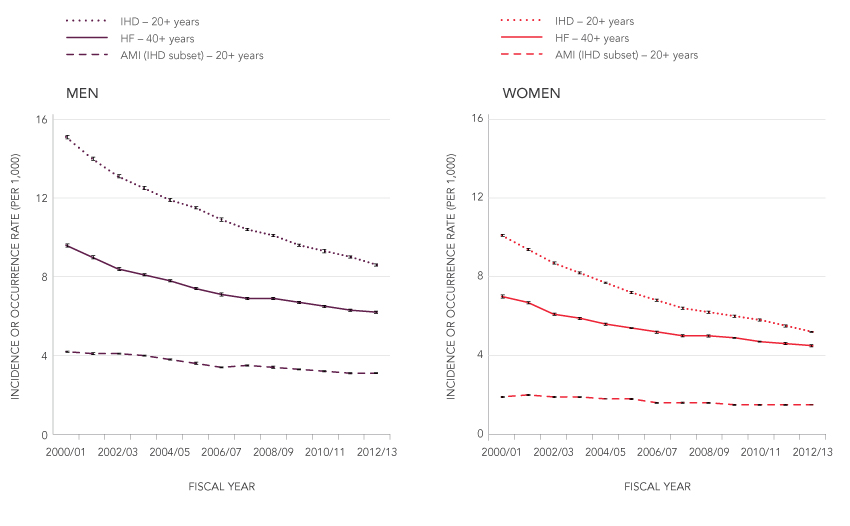
† Age-standardized to the 2011 Canadian population. *Data from Yukon were not available.
Notes: The 95% confidence interval shows an estimated range of values which is likely to include the true value 19 times out of 20.
Source: Public Health Agency of Canada, using Canadian Chronic Disease Surveillance System data files contributed by provinces and territories, May 2016.
Figure 2 - Text Description
| Ischemic heart disease | ||
| Fiscal Year | Incidence rate among women aged 20 years and older | Incidence rate among men aged 20 years and older |
| 2000/01 | 10.1 | 15.1 |
| 2001/02 | 9.4 | 14.0 |
| 2002/03 | 8.7 | 13.1 |
| 2003/04 | 8.2 | 12.5 |
| 2004/05 | 7.7 | 11.9 |
| 2005/06 | 7.2 | 11.5 |
| 2006/07 | 6.8 | 10.9 |
| 2007/08 | 6.4 | 10.4 |
| 2008/09 | 6.2 | 10.1 |
| 2009/10 | 6.0 | 9.6 |
| 2010/11 | 5.8 | 9.3 |
| 2011/12 | 5.5 | 9.0 |
| 2012/13 | 5.2 | 8.6 |
| Heart failure | ||
| Fiscal Year | Incidence rate among women aged 40 years and older | Incidence rate among men aged 40 years and older |
| 2000/01 | 7.0 | 9.6 |
| 2001/02 | 6.7 | 9.0 |
| 2002/03 | 6.1 | 8.4 |
| 2003/04 | 5.9 | 8.1 |
| 2004/05 | 5.6 | 7.8 |
| 2005/06 | 5.4 | 7.4 |
| 2006/07 | 5.2 | 7.1 |
| 2007/08 | 5.0 | 6.9 |
| 2008/09 | 5.0 | 6.9 |
| 2009/10 | 4.9 | 6.7 |
| 2010/11 | 4.7 | 6.5 |
| 2011/12 | 4.6 | 6.3 |
| 2012/13 | 4.5 | 6.2 |
| Acute myocardial infarction (ischemic heart disease subset) | ||
| Fiscal Year | Occurrence rate among women aged 20 years and older | Occurrence rate among men aged 20 years and older |
| 2000/01 | 1.9 | 4.2 |
| 2001/02 | 2.0 | 4.1 |
| 2002/03 | 1.9 | 4.1 |
| 2003/04 | 1.9 | 4.0 |
| 2004/05 | 1.8 | 3.8 |
| 2005/06 | 1.8 | 3.6 |
| 2006/07 | 1.6 | 3.4 |
| 2007/08 | 1.6 | 3.5 |
| 2008/09 | 1.6 | 3.4 |
| 2009/10 | 1.5 | 3.3 |
| 2010/11 | 1.5 | 3.2 |
| 2011/12 | 1.5 | 3.1 |
| 2012/13 | 1.5 | 3.1 |
Men with diagnosed ischemic heart disease and heart failure are 20% and 10% respectively more likely to die, on average, than women (Figure 3). For both conditions, the gap between men and women is closing over time. Finally, women who had a heart attack are 30% more likely to die, on average, than men who had a heart attack (Figure 3). The greater likelihood of death in women who had a heart attack has already been documented and the disparity is greater for younger and middle-aged women. This may be due in part to the fact that women have more comorbid conditions (such as diabetes, obesity, and depression) than men, more subtle symptoms (e.g. weakness, shortness of breath) and sometimes the absence of chest pain, resulting in underdiagnoses, a longer delay in presenting to the hospital after symptom onset, and more bleeding complications after being administered certain therapies.Footnote v ,Footnote vi ,Footnote vii
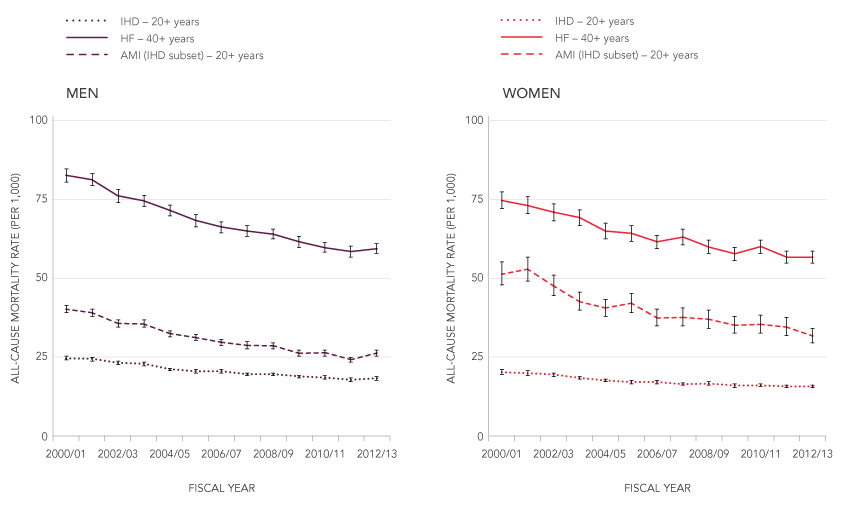
† Age-standardized to the 2011 Canadian population. *Data from Yukon were not available.
Notes: The 95% confidence interval shows an estimated range of values which is likely to include the true value 19 times out of 20.
Source: Public Health Agency of Canada, using Canadian Chronic Disease Surveillance System data files contributed by provinces and territories, May 2016.
Figure 3 - Text Description
| Ischemic heart disease | ||
| Fiscal Year | All-cause mortality rate among women aged 20 years and older with ischemic heart disease | All-cause mortality rate among men aged 20 years and older with ischemic heart disease |
| 2000/01 | 20.2 | 24.6 |
| 2001/02 | 19.9 | 24.5 |
| 2002/03 | 19.5 | 23.2 |
| 2003/04 | 18.4 | 22.9 |
| 2004/05 | 17.6 | 21.2 |
| 2005/06 | 17.1 | 20.5 |
| 2006/07 | 17.1 | 20.5 |
| 2007/08 | 16.4 | 19.6 |
| 2008/09 | 16.6 | 19.6 |
| 2009/10 | 16.0 | 18.9 |
| 2010/11 | 16.0 | 18.5 |
| 2011/12 | 15.7 | 17.8 |
| 2012/13 | 15.7 | 18.3 |
| Heart failure | ||
| Fiscal Year | All-cause mortality rate among women aged 40 years and older with heart failure | All-cause mortality rate among men aged 40 years and older with heart failure |
| 2000/01 | 74.7 | 82.7 |
| 2001/02 | 73.1 | 81.3 |
| 2002/03 | 71.0 | 76.2 |
| 2003/04 | 69.3 | 74.6 |
| 2004/05 | 65.0 | 71.6 |
| 2005/06 | 64.3 | 68.4 |
| 2006/07 | 61.6 | 66.3 |
| 2007/08 | 63.1 | 65.0 |
| 2008/09 | 59.9 | 64.0 |
| 2009/10 | 57.8 | 61.6 |
| 2010/11 | 60.1 | 59.7 |
| 2011/12 | 56.7 | 58.5 |
| 2012/13 | 56.7 | 59.4 |
| Acute Myocardial Infarction (ischemic heart disease subset) | ||
| Fiscal Year | All-cause mortality rate among women aged 20 years and older who had an acute myocardial infarction | All-cause mortality rate among men aged 20 years and older who had an acute myocardial infarction |
| 2000/01 | 51.3 | 40.2 |
| 2001/02 | 52.9 | 39.1 |
| 2002/03 | 47.6 | 35.7 |
| 2003/04 | 42.6 | 35.5 |
| 2004/05 | 40.6 | 32.5 |
| 2005/06 | 42.1 | 31.2 |
| 2006/07 | 37.4 | 29.7 |
| 2007/08 | 37.6 | 28.7 |
| 2008/09 | 37.0 | 28.6 |
| 2009/10 | 35.1 | 26.2 |
| 2010/11 | 35.4 | 26.4 |
| 2011/12 | 34.5 | 24.2 |
| 2012/13 | 31.7 | 26.3 |
Heart Disease Occurs More Often as Canadians Age
The prevalence of diagnosed ischemic heart disease increases as people age (Figure 4) and is higher among men than women in all age groups.
Similar patterns are observed for acute myocardial infarction and heart failure (not shown). For instance, the prevalence and incidence of acute myocardial infarction among men 25–44 years of age are on average about four times higher than those of women in the same age group. Nonetheless, as women and men get older than 65 years old, the gap in prevalence and incidence lessens. In fact, in 2012/13, there is almost twice as many women aged 85 years and older newly diagnosed with ischemic heart disease than men of the same age. As women live longer than men, they are more likely to be diagnosed with a heart condition in the old age.
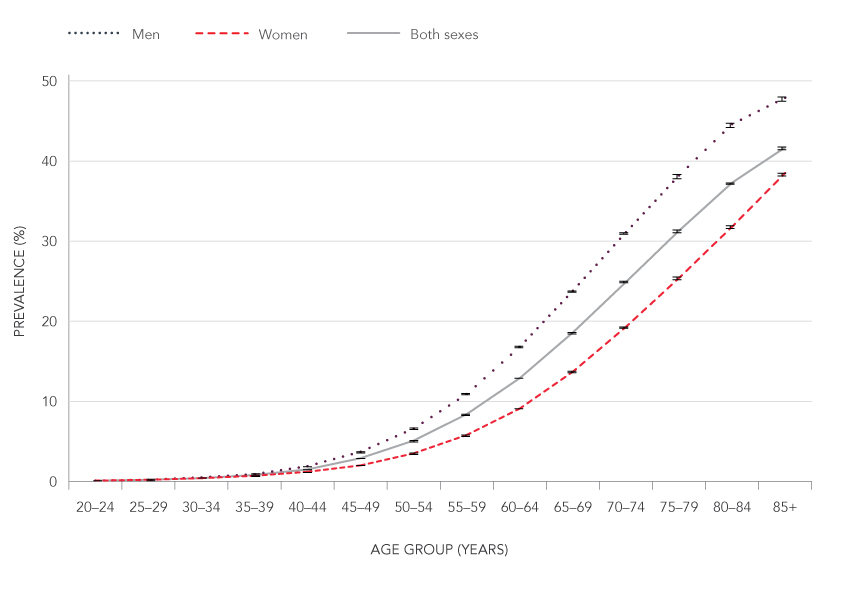
* Data from Yukon were not available.
Notes: The 95% confidence interval shows an estimated range of values which is likely to include the true value 19 times out of 20.
Source: Public Health Agency of Canada, using Canadian Chronic Disease Surveillance System data files contributed by provinces and territories, May 2016.
Figure 4 - Text Description
| Age Group (Years) | Prevalence (%) | ||
| Women | Men | Both sexes | |
| 20–24 | 0.1 | 0.1 | 0.1 |
| 25–29 | 0.2 | 0.2 | 0.2 |
| 30–34 | 0.4 | 0.5 | 0.4 |
| 35–39 | 0.7 | 0.9 | 0.8 |
| 40–44 | 1.2 | 1.9 | 1.5 |
| 45–49 | 2.0 | 3.7 | 2.9 |
| 50–54 | 3.5 | 6.6 | 5.1 |
| 55–59 | 5.8 | 10.9 | 8.4 |
| 60–64 | 9.1 | 16.8 | 12.9 |
| 65-69 | 13.7 | 23.8 | 18.6 |
| 70–74 | 19.3 | 31.1 | 24.9 |
| 75–79 | 25.4 | 38.2 | 31.3 |
| 80–84 | 31.8 | 44.6 | 37.3 |
| 85+ | 38.5 | 47.9 | 41.7 |
Heart Disease Can Be Prevented
Although a family history of early heart disease as well as older age increases one’s risk of heart disease, it is possible to control certain risk factors to lessen such a risk. Avoiding smoking, being physically active, adopting a healthy diet, achieving and maintaining a healthy weight, managing stress effectively, and the early detection and management of conditions such as hypertension, diabetes and high cholesterol can help reduce your risk.
How to Learn More about Heart Disease
Visit www.canada.ca and Search: heart disease
Get data http://infobase.phac-aspc.gc.ca/ccdss-scsmc
Follow us https://twitter.com/phac_gc
Like us www.facebook.com/public-health-agency-of-canada-10860597051
More www.heartandstroke.ca
* What's in the Data?
The data used in this publication are from the Canadian Chronic Disease Surveillance System (CCDSS), a collaborative network of provincial and territorial chronic disease surveillance systems, led by the Public Health Agency of Canada (PHAC). The CCDSS identifies chronic disease cases from provincial and territorial administrative health databases, including physician billing claims and hospital discharge abstract records, linked to provincial and territorial health insurance registry records using a unique personal identifier. Data on all residents eligible for provincial or territorial health insurance (about 97% of the Canadian population) are captured in the health insurance registries.
Trends in incidence rates may reflect true change in population health status, but may also be a function of change in administrative data characteristics of change in administrative data characteristics or collection methods. Factors such as coding/ classification systems, clinical practices, and/or billing methods may all influence the rates that are estimated from administrative data.
Disease definitions: 1) people with diagnosed heart disease were identified as individuals aged 20 years and older having either one hospitalisation record, or procedure or two physician claims in one year with an International Classification of Diseases code for heart disease, 2) acute myocardial infarction is defined as those individuals aged 20 years and older having one hospital admission with an International Classification of Diseases code for acute myocardial infarction, 3) people with diagnosed heart failure are identified as individuals aged 40 years and older having either one hospitalisation record or two physician claims in one year with an International Classification of Diseases code for heart failure.
Acknowledgments
This work was made possible through collaboration between PHAC and all Canadian provincial and territorial governments and expert contribution from the CCDSS Heart Disease Working Group. This fact sheet was developed by PHAC; no endorsement by the provinces and territories is intended or should be inferred.